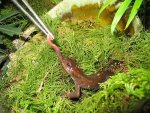I have had a mature female Northwestern salamander, who is about 5", for the better part of a week and she just wont eat.

I have recreated her natural environment and have tried several different types of food (small feeder fish, small crickets, red wiggler worms) and have her on a regular night day schedule.
At this point i am concerned, how long can salamanders go without eating?
Any ideas?
I have recreated her natural environment and have tried several different types of food (small feeder fish, small crickets, red wiggler worms) and have her on a regular night day schedule.
At this point i am concerned, how long can salamanders go without eating?
Any ideas?
Last edited:

